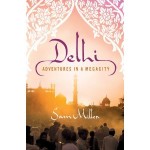The soles of your feet are exquisitely communicative. Tickle them, and feel the spine-tingling jolt rush right to your scalp; flog them, and understand why they are the torturer’s first resort. Ay, caramba! – the feet do not lie.
So, too, when you simply let them pad about, taking in the grain and peal of the land. There is no better way to experience a sense of place than taking a walk. Sam Miller took a grand one, a great spiraling ambulation starting at the heart of Delhi and working its way to the outer precincts.
Miller embarked on his gyre around the city with deliberation – as device, as metaphor – to govern the chaos before him with direction and purpose. He was required to pass through the quotidian, yet allowed the flashes of serendipity that are the meat and potatoes of travel writing.
Though he has a map and a plan, Miller casts himself as a flaneur – “someone who wanders aimlessly through cities” – drifting in particular through unfamiliar neighborhoods and drinking in their ambience: the lay of the land, the light and street life, immediate attractions and spontaneous encounters, and observing how they affect his mood – a psychogeography.
That he finds a Delhi in flux is no great surprise; cities everywhere are always in flux. What galls him is that “Delhi, this city I had been seduced by” – Miller has lived there for nearly a decade, where he works for the BBC – “was itself being seduced by the West. Delhi was beginning to be just like anywhere else.” And certainly, to a point, this is true. Delhi has its share of malls and mall culture, and it is hard to throw a samosa without hitting a global brand or generic fast-food joint.
But, happily, even the golden arches has had to bevel its approach. No Big Macs here; rather, how about a Chicken McCurry, or perhaps a nice McAloo Tikki? Even as the world shrinks and homogenizes, Miller is heartened to see that in unexpected ways, the West is having to make concessions.
He starts his journey at Connaught Place, a piece of British city planning smack in old Delhi, whose concentric rings could easily be at home in London or Glasgow. Once a Victorian park, it now seethes with modernity as an interchange in the Delhi Metro system – one of many unifying threads that run through the book – as well as an underground bazaar selling everything from Minnie Mouse wall hangings to bust-developing cream, pirated movies to the much-heralded “Intellectual Ionic Hair Permer.”
Outward he spins, light on his worldly feet, the writing easy but attentive, for Delhi is as layered as a mille feuille and throws much at the traveler. It is not enough for Miller to just chronicle what he encounters; he likes context and does his homework to let readers know why the swastika is used with respect in the city’s Jewish cemetery, why there is Star of David stonework in a Muslim fort, and what lies behind the “All-India Sports Council for the Deaf” and “National League of Pen-Friends” offices.
He marvels at the spectacular and varied architecture that sits by chance in the swath cut by his spiral, thus testifying that there is much more to be seen, and he has his share of dangerous close encounters: one at an open-air slaughterhouse where the butchers take menacing exception to his nosy nose, another when a couple of feral pigs locked him in their sights (they had recently killed a child).
Miller covers a lot of ground by keeping his spirals tight – his foot-borne skirmish with the city takes place over several years – and making quick notes of what he sees; quick, but telling and chromatic, and accruing into a kaleidoscopic Delhi: the stink of the fish market, the ancient step well of Agarsen’s Baoli, slums and slum-dwellers, the shamefully rancid secret of the Yamuna River (the color of licorice), the Heartthrob Talent Agency, genteel bungalows, the guy who bicycles along the highway and collects vehicular emissions with a magnet on a string, the gift shop at the Tibar Jail, the huge, pink abstract sculptures in Jantar Mantar park – children climb all over them – that are actually 300-year-old scientific instruments to measure azimuths and meridians.
Miller’s Delhi is a messy, class-driven, smelly, beautiful thing, if a place aching for city planning that doesn’t pretend the poor don’t exist. But something is in the air that doesn’t like color or deliquescence, and you yearn to be like Miller, in his thousands of footsteps, there now, feeding your inner flaneur on Delhi’s quiddities.
(from the San Francisco Chronicle)
